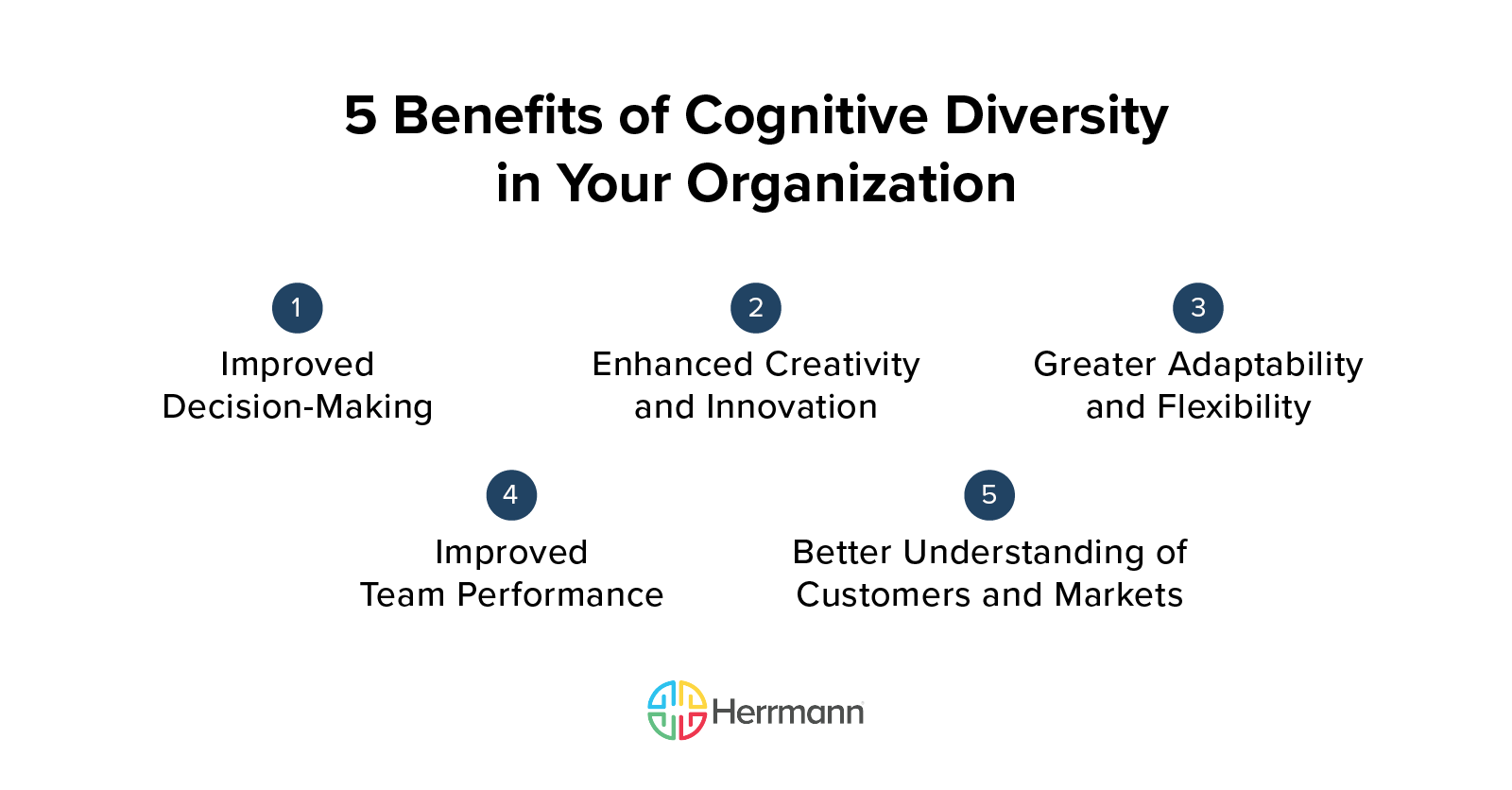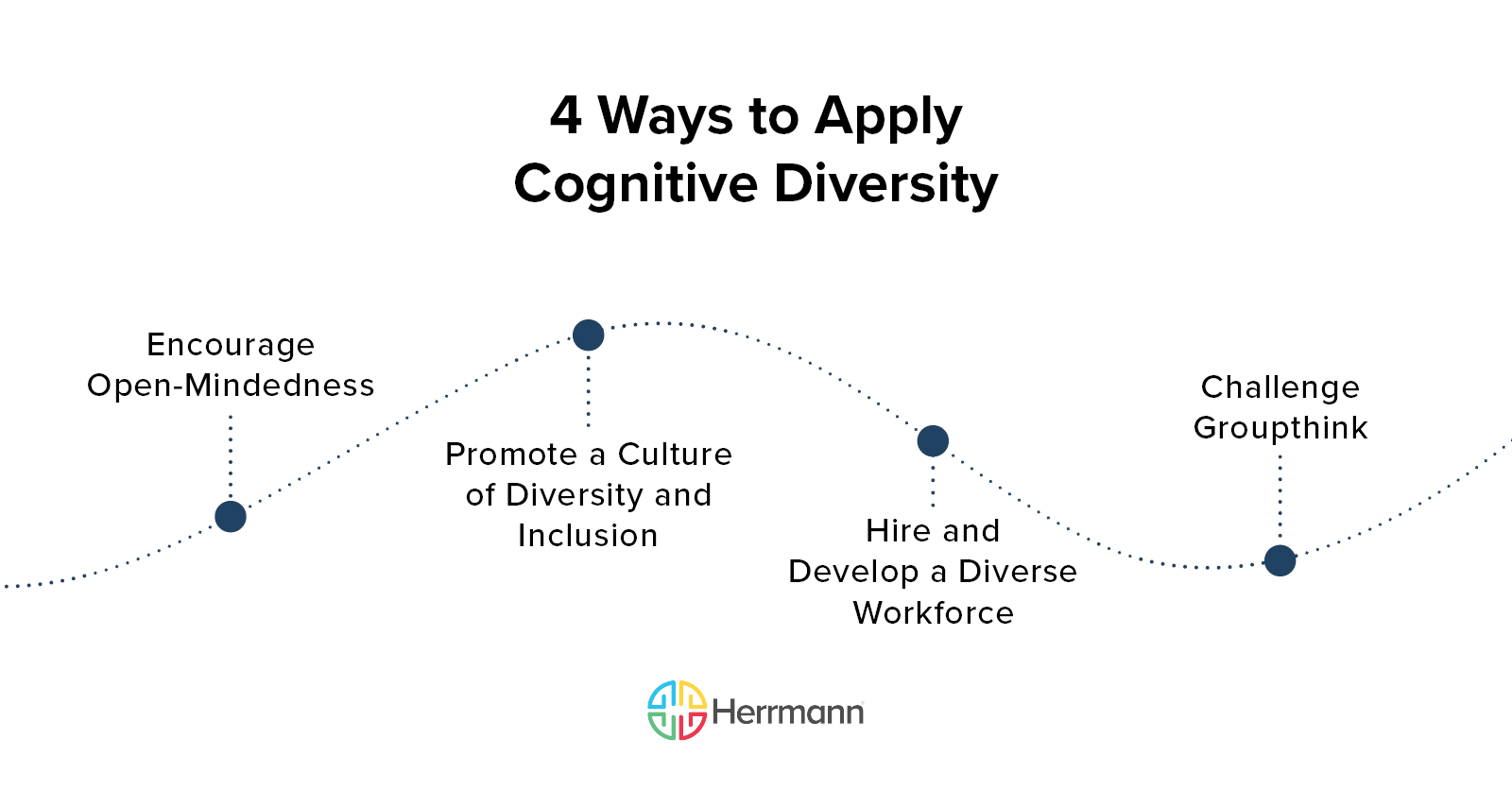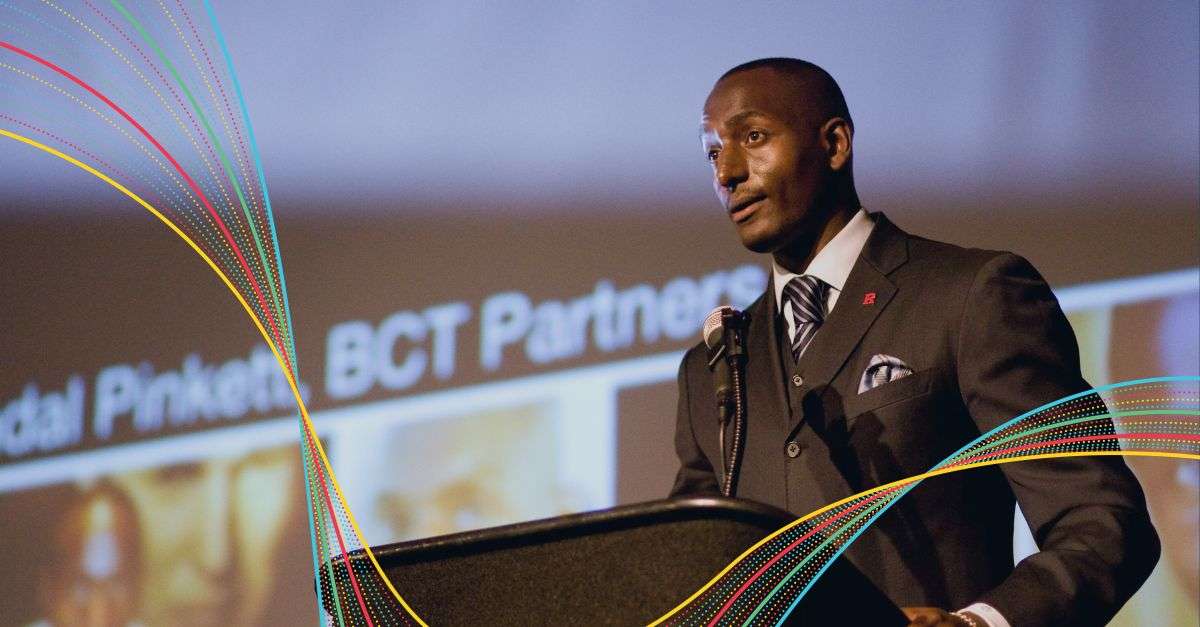As organizations strive to build diverse and inclusive workplaces, it's important to understand the role that cognitive diversity can play.
Diversity and inclusion show up in many ways. Cognitive diversity is a powerful way to show your team how diversity empowers better thinking, mutual respect, and improved performance. Leaders who create this type of inclusive culture find their teams are more creative, engaged, and successful.
Explore the role of cognitively diverse teams inside successful organizations, how Whole Brain® Thinking develops this trait and how to foster greater diversity and inclusion in your organization.
What Is Cognitive Diversity in the Workplace?
Diversity is often discussed in terms of race, ethnicity, gender, sexual orientation, and other demographic characteristics. Some definitions also look at personality differences, work styles, diversity of experiences, and levels of education. All of these elements of diversity are important.
Cognitive diversity addresses the variety of perspectives and viewpoints each member of the team brings. People have different ways of thinking, processing information, and making decisions. Despite the name, diversity of thought in the workplace isn’t merely a feeling or expression. It’s an actionable trait you can measure and cultivate within your team.
Cognitive diversity can be a major asset in the workplace. Teams that embrace a variety of perspectives are more prepared to solve problems, identify new opportunities, and craft innovative solutions.
The Whole Brain® Thinking framework is one tool you can use to develop a cognitively diverse workforce. The framework represents a four-quadrant model of the brain that’s based on research by Ned Herrmann. The quadrants represent four thinking styles: analytical, intuitive, creative, and practical.
By understanding the strengths and weaknesses of each style, teams can better understand each other and collaborate more effectively.
The Role of Cognitive Diversity in Promoting Diversity and Inclusion in the Workplace
Because cognitive diversity embraces differences and shows how people’s different thinking preferences positively influence teams, the concept is a powerful example of diversity in practice. Moreover, leaders who cultivate diversity of thinking are creating an inclusive environment that welcomes differing or even competing ideas. These leaders deliberately avoid homogeneity in their work and in how they staff teams, demonstrating diversity and inclusion principles in their day to day.
Many organizations practice some form of cognitive diversity, even if they don’t realize it. Being aware and mindful of this practice can elevate its importance, allowing leaders to connect it to their formal diversity, equity and inclusion strategies.
Can Cognitive Diversity Affect Company Performance?
Perhaps the most obvious way cognitive diversity affects performance is by turning differences into a strength instead of a weakness. This doesn’t happen automatically. While you can build teams that feature a variety of perspectives and thinking styles, that doesn’t mean people will respect those differences, much less embrace them. When cognitive diversity is badly handled or ignored, performance could decline because of increased conflict.
However, cognitive diversity done well can have tangible effects on team productivity, idea generation, project execution, change management, resiliency, and problem-solving. These effects can be measured, especially with a baseline comparing how your organization performed before and after cognitive diversity-related efforts.
How Cognitive Diversity Can Benefit Your Organization
Sign up to our newsletter for the latest insights
Improved Decision-Making
Identifying problems and finding solutions isn't a one-person job. The best decisions are made when leaders can look to a diversity of experiences and backgrounds to get a 360-degree understanding of what needs to be done.
A cognitively diverse workforce allows leaders to move past their thinking and potential biases. They and their teams are more likely to spot errors or gaps in thinking — and propose creative, long-term solutions. When leaders seek out different perspectives and welcome constructive criticism of ideas and strategies, people feel safer speaking up. Great ideas aren’t lost because someone feared speaking up or because groupthink turned the process into a fait accompli.
Enhanced Creativity and Innovation
Common wisdom can help establish norms and repeatable processes, but the most creative ideas rarely come from studying the status quo. You need a new source of information and inspiration, and gathering people with a variety of backgrounds and experiences is one way to spark creativity.
Embracing a cognitively diverse team means creating an environment where employees feel like they can voice their ideas and solutions. Ideation is a process, so employees need to feel comfortable talking through their concepts, getting input from co-workers, and collaboratively deciding on the best approach. Teams that practice diversity of thought often develop final products that are a collection of everyone’s contributions, not one lone genius’ idea.
Greater Adaptability and Flexibility
A cognitively diverse team grapples with uncertainty every day. They’re ideally suited to weather change, disruption, and disagreement — and move forward productively. And in today’s constantly changing business landscape, companies need to adapt quickly to challenges, especially sudden and unforeseen changes.
Whether it’s changing processes to fit a new business need or reshaping a team’s job duties, a cognitively diverse workforce can summon the flexibility to meet the challenge.
Improved Team Performance
Cognitive diversity can generate increased productivity and efficiency within a team. By encouraging different ways of thinking, team members are more likely to come up with new and innovative ideas. They can also find new ways of doing day-to-day tasks and processes. These iterative improvements might not be as visible, but they can yield massive aggregate improvements in output and efficiency.
Organizations that embrace the diversity of thought are also likely to improve performance by avoiding mistakes, miscommunication and errors of omission. They’re used to working through differences to find commonalities, so they’re less likely to make assumptions or avoid conflict.
Better Understanding of Customers and Markets
All the benefits of cognitive diversity ultimately affect clients, customers, or end users. The impact can be more direct and measurable when companies apply the Whole Brain® Thinking model to cross-functional teams, such as your sales organization.
These teams break down silos between departments, share knowledge and build trust, which enables everyone to serve customers better and take advantage of emerging market opportunities.
For example, on a cross-functional sales team, your account executives might be predominantly Red thinkers, given their interpersonal skills and close client relationships. Your analysts might be Blue thinkers, and your operations leaders make sure customers get what they need with their Green preference for organization and planning.
These functions can succeed even if they aren’t working closely together. But as a unified team bringing their perspective to bear, they can reach unprecedented heights.

How Do Cognitively Diverse Teams Look?
Cognitively diverse teams don’t have one distinctive “look,” but you might notice how they approach challenges and solve problems differently than traditional teams.
For example, cognitively diverse teams typically have a wider range of perspectives and experiences to draw from. This can make them better equipped to solve complex problems, adapt to disruption, and take informed risks.
Many teams struggle to agree on how to approach work tasks, oftentimes because team members don’t understand each other’s thinking preferences and communication styles. Cognitively diverse teams that rely on Whole Brain® Thinking have this information at their fingertips, helping them explore differences with empathy and collaboration rather than conflict.
How to Foster Cognitive Diversity in the Workplace
Cognitive diversity starts with the example set by leaders and managers. They must become aware of their biases and blind spots while helping their teams do the same.
Managers model these behaviors in day-to-day interactions, including standing meetings and brainstorming sessions. When leaders solicit ideas and feedback, even when they challenge existing beliefs, people will see that their perspectives and thinking preferences are valued. But if you're not open to different ideas, your team won't be, either.
Here are some ways to develop diversity of thinking within your workplace.
Encourage Open-Mindedness and Inclusivity
Create a culture that doesn’t just tolerate differing opinions and perspectives but welcomes them for the greater good. Employees need to feel safe to share what’s on their minds.
One way to do this is to have regular team-building activities that promote collaboration and communication. Give everyone a chance to contribute, and make it clear that positive contributions are the goal, not giving the “right” answer or hewing to the company line.
Whole Brain® Thinking can make this process more natural when everyone knows their HBDI® profile. With that information out in the open, people can be themselves and welcome everyone’s contributions and thinking preferences.
Promote a Culture of Diversity and Inclusion
Promoting diversity and inclusion means valuing everyone’s differences and ensuring people feel accepted. While Human Resources contribute to this effort, managers are crucial.
When everyone feels valued and included, they're more likely to be open to hearing and sharing different perspectives. In turn, your team’s thinking will be more diverse, innovative, and successful.
Hire and Develop a Diverse Workforce
There are often many qualified candidates in today’s job market for any particular role. Too many companies struggle to find the right external candidates or develop their internal talent. There are many reasons for this, but one cause is that leaders look for a certain “type” of person instead of casting a wide net for skills, experience, and expertise.
Cognitive diversity requires sourcing from a diverse pool of candidates. But diversity as a hiring strategy isn't enough. Those hires don’t all think the same, have the same interests, or want the same career path. If you hire for diversity, you also need to be inclusive in how you train and develop those new hires. Help them maximize their strengths and pursue career paths that make sense to them.
The increase in hybrid and remote work structures is another opportunity for leaders to welcome and include candidates of different backgrounds, career goals, and life circumstances.
Cognitive diversity in hiring is about helping people flourish and add to your culture rather than forcing them to conform to your organization’s default thinking preferences.
Encourage Diverse Thinking and Challenge Groupthink
Leaders don’t know it all, but they do set the tone. You should model continuous learning in all your interactions with your team, especially when trying to solve thorny or novel problems.
The beauty of being on a team is the ability to strategize, talk through different ideas, and test theories with allies at your side. Rather than default to groupthink, challenge the status quo and make room for new ideas and innovation on the team and for the company.

Get Started With Cognitive Diversity
The truth is that every company can benefit from cognitive diversity, but they aren’t taking advantage of this powerful approach. Like diversity and inclusion efforts, leaders and managers are powerful influencers who determine whether your organization accepts the challenges or is content with the old ways of working. When you embrace a diversity of thought, you set yourself, your team, and your organization up for better thinking, improved creativity, and sustained success.
Interested in learning more? Discover how to improve business intelligence reports with cognitive diversity and talent data.












